Chronology:Events
of the decade leading up to the publication of the Wizard newspaper.
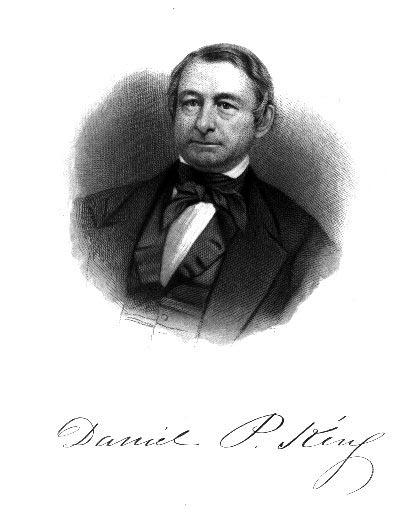
Fig. 4.1. Daniel Putnam
King
4 FEBRUARY 1850
Leaders
The town’s representative in Congress, DANIEL P. KING, wrote to his family
on Lowell Street from Washington D.C.. “The House adjourned and we heard
a great speech from HENRY CLAY on the desirableness of the Union.
The hall was crowded and many had stood three hours to hear him.
The Southern men generally feel very bitter and very determined to rule
or ruin all, but I shall not flinch. They will get not more concession
and no more slave power with my consent.”
15 FEBRUARY 1850
National The new Fugitive
Slave Law prompted a mob to rescue SHADRACH, an accused fugitive, from
Boston jail. The government mandated that the fugitive must be returned
as outlined by the law, which angered many Northerners.
10 JULY 1850
National News of the death of PRESIDENT
ZACAHARY TAYLOR arrived by telegraph. MILLARD FILLMORE assumes office.
25 JULY 1850
Leaders DANIEL P. KING died unexpectedly
at his home on Crystal Lake. The House of Representatives formally announced
King’s death two days later and many tributes were offered in remembrance
of the “fervid and earnest pleas for liberty and human rights", which
King uttered on the floor of Congress.
6 MAY 1852
Leaders LOUIS
KOSSUTH (1802-1894), the leader of the 1848 Hungarian revolution against
Austria, visited the Lexington Monument at Main and Washington streets.
He compared the patriots of the American Revolution with the Hungarian
patriots seeking independence from the czar of Russia.
20 AUGUST 1853
Education On another hot, sunny
day, the cornerstone of the new Peabody Institute was laid on Main Street.
The ceremonies were attended by several dignitaries.
As requested
by GEORGE PEABODY, the cornerstone was laid by industrialist ABBOTT LAWRENCE
along the northwest angle of the site. He said, “We have a great
labor yet to perform. We live in a country increasing in the number
of its people at the rate of a million a year! And, our only security for
the preservation of our freedom and our republican institutions is to educate
the people. Not only let there be education, but let it be universal
– a universal education of the people – and this is the purpose of the
institution whose foundation-stone we are called upon to place today.
It is one of the germs of this universal education.”
7 JUNE 1855
Government The first town meeting
was held and sixty-three men were elected to various posts. The fire
department has six hand fire engines, six hose carriages, a sail
carriage, and one hundred and eighty members.
9 OCTOBER 1856
George Peabody A cone of streamers
of various colors festooned from the peak of the roof of the one-year
old Peabody Institute on Main Street to mark the parade and reception for
GEORGE PEABODY held jointly by Soutb Danvers and Danvers.
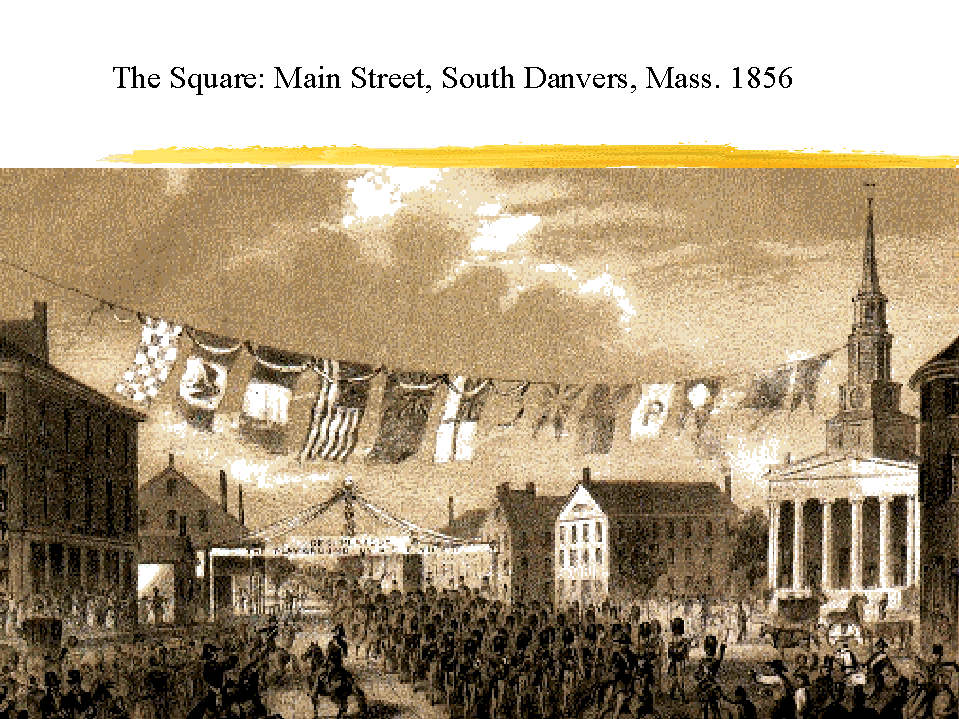 Fig. 4. 4 The Square during
the 1856 Parade and Reception for George Peabody
Fig. 4. 4 The Square during
the 1856 Parade and Reception for George Peabody
Peabody moved
in an elegant carriage drawn by six horses and proceeded to the parade
route. Visiting the Institute on Main Street the following day,
he “entered his name as an applicant for books.”
A crowd of people
met him at the square in Danvers when he left. “A chain of little
children holding hands had stopped his carriage. He bowed to the
people and thanked the citizens for the public honors he had received.”
14 AUGUST 1857
George Peabody It was a sea
of stove pipe hats and bonnets, parasols and fans – thousands of people
in the humid heat jostling each other while they scrambled to get a seat
on one of the coaches that arrived every five minutes. The dust and
smell of horses filled the air in the Square.
A few days before
sailing for England, George Peabody agreed to revisit his birthplace.
A simple picnic for three thousand, “Mr. P” called it the highlight
of his visit.
It took place
about a mile and half from the square at King’s Grove, in spite of the
lowering and doubtful weather. All the citizens of the town, old
and young, were invited to the gathering where swings and seats were tucked
in the field and forest. Eighteen tables were arranged which set
end-to-end would have measured close to one thousand feet. They were
covered with cloth from the Danvers Bleachery, and were spread with offerings
provided by the women of the town.
NOVEMBER 1857
Leaders
JAMES BUCHANAN was elected fifteenth President of the United States.
4 JANUARY 1858
Education The new school
on Central Street was dedicated. Two years later it was named in
honor of NATHANIEL BOWDITCH (1773-1838), who attended school in that area
as a child. Born in Salem on March 26, 1773, Bowditch moved to Danvers
as an infant.
“His paternal
ancestors had been shipmasters for several generations, but his father
retired from that occupation, and became a cooper. He began to manifest
remarkable faculties at an early age although he stopped attending school
at the age of ten. He acquired the Latin and French languages
for the sake of translating Newton’s Principia and La Place’s Mechanique
Coleste, and arrived at a height of Mathematical greatness far above his
contemporaries.
“His work on
practical navigation is the best in the world and is used universally by
American sailors. Difficult problems and the abstruse windings of
Mathematics were his passion, and those calculations which were inscrutable
to other men were sport to him.
“He navigated Salem
Harbor in a small pleasure boat for the purpose of experiment and rendered
his conclusions susceptible of demonstration.”
He died one of
the most remarkable men of his day, March 16th, 1838, at age sixty-five.
An ancient landmark,
a pine tree that was significant in the minds of residents even after it
disappeared, was located near where Bowditch spent his childhood. The townspeople
said the tree was at his root.
The tree was described as having long
arms stretched out near its top and as being deprived of branches below.
It was “an old settler of the forest totally unlike any other tree around
it” and its age was unknown. It was believed that it was a familiar
object to those who came to the hanging tree in Salem to witness the execution
of the witches in 1692.”
In the 1700’s,
the giant pine tree fell to the earth. “That old pine tree is associated
in our minds by many early recollections - not that we ever saw it, for
it was gone long before our time - but its name remained,” reported the
Danvers Courier.
“Its memory is cherished, embalmed in the hearts of our townsmen,
It stood at a corner, at one of the outposts of our village. Everybody
who knew anything, knew about the pine tree. It gave character and
consequence to the neighborhood about it. Travelers were directed
by it. Citizens venerated it and its fame become immortal!
“We have said
we never saw the pine tree, but in our boyhood, we had our designs of ambition
and wished to stray into foreign parts and unknown regions. We had
as great longing to see the pine tree as ever had Columbus to see the New
World. How did our little hearts beat and our eyes dance when under
the paternal guidance, we had the promise of a ride to - aye - beyond the
pine tree. It was only a place, a name, an immortal name and perhaps
it is engraven all the deeper in our memory for the disappointment.”
JUNE 1858
Education Under the district school
system, each school was provided for and maintained by the residents of
the surrounding neighborhood, which caused great disparity in the quality
of education. School districts were renamed:
District 1: Wallis School
District 2: Center School
District 3: Bowditch School
District 4: Rockville School
District 5: Locust Dale School
District 6: Felton School
District 7: West School
District 8: Suntaug School
16 AUGUST 1858
Life/Customs President JAMES BUCHANAN
and QUEEN VICTORIA exchange greetings across the newly laid Atlantic cable.
11 NOVEMBER 1858
Arts/Culture RALPH WALDO EMERSON
lectures on “Memory” at the Peabody Institute.
1 DECEMBER 1858
Life/Customs The occasion of the
“Dinner of the Rocks”, one of the most characteristic and successful practical
jokes pulled off by town humorist FITCH POOLE.
“In the early
days of the Peabody Institute lectures, Professor Hitchcock, “an eminent
geologist”, delivered a course of lectures and while in town he was entertained
by Fitch Poole. A large number of the people of the town were invited
to meet him at a party at Poole’s home on Main Street.
“When the time
for refreshments arrived, the company was ushered into a well supplied
supper room, and just at that moment the host was called away for a moment,
and excused himself with a cordial invitation to his guests to help themselves
of the good things before them.
“After the first
descent upon the table, a strange embarrassment stole over those who endeavored
to dispense the refreshments. One would take off the cover from a
dish, and hastily replace it; another found the oysters of surprising weight
and texture; the cake could scarcely be lifted; the ice creams and custards
could be carried about bodily by the spoons inserted in them; each new
dish was more puzzling than the last. At length it dawned upon the
brighter spirits, that here was truly a geological feast, and the laugh
began.
“The oysters
were pudding-stone; the cake was brick, frosted with plaster of Paris;
custards and creams were of plaster colored and molded; sugar, cream, every
detail of the banquet was of mineral origin, of plaster, or stone or clay.
When the fun began to subside, another door was thrown open, and a more
edible repast was spread before the guests.”
6 APRIL 1859
Education An act to abolish the
school district system was approved by the state legislature. It
required the town to provide and maintain the schools.
16 JULY 1859
Leaders Death of RUFUS CHOATE
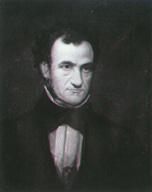
Fig 4.6 Rufus Choate
l
(1799-1859) The keynote speaker at the
dedication of the Peabody Institute, Choate was a local lawyer and legislator
who went on to serve in the U.S. Congress. While there, he was a
prime influence in establishing and defining the Smithsonian Institute
- seven years before the Peabody Institute on Main Street opened.
The Smithsonian Institute
was created in 1846, when, over the protests of some, the Congress voted
to accept a half-million dollar bequest to establish an institute in Washington
for the “increase and diffusion of knowledge among men.”
The gift was made by
JAMES
SMITHSON, the wealthy, illegitimate son of a European Duke. He had
no connection with the United States.
In the Senate, the
bequest was assigned to the Library Committee, of which Choate was a member.
He argued that a plan championed for an institution for the teaching of
natural history, chemistry, astronomy and science, would result in “a pretty
energetic diffusing of the fund; not much diffusion of knowledge.”
Instead, he proposed
a program of lectures by visiting luminaries in science and literature,
to be held during sessions of Congress. The rest of the money would
be spent “accumulating a grand and noble public library; one which, for
variety, extent and wealth, shall be, equal to any now in the world.”
Despite being severely
ill on the day of the Institute’s dedication, Choate gave an eloquent address
that lasted for an hour and ten minutes, “without the listeners discerning
his suffering.” The topic of his speech was the “true idea and office
of the Lecture in connection with the library” which he perceived to be
“a means of intellectual culture.”
The library’s
first Lyceum Committee adopted Choate’s recommendation to have one or more
courses of lectures on some single subject from the same person.
Choate was known
as a great orator, a founder of the Whig party in the state and “the wizard
of the bar." When he argued cases at the Salem Court House,
crowds of people would wait outside and rush in to take their seats when
he began to speak. He once persuaded a jury to acquit a client of
a murder charge, pleading the crime was committed while the client was
sleep walking.
He opened his
law practice in the early 1800’s and went on to serve in the state legislature.
Eventually, he continued to the U.S. Congress to fill a seat vacated by
DANIEL
WEBSTER. Choate was an avid book collector, one of the early members
of the Danvers Literary Circle and of the town’s first Unitarian Church. |
About South Danvers (Peabody), Massachusetts
Marked by the traces of glaciers, the tidal basins of the Waters and
North rivers and numerous brooks, Peabody, Massachusetts emerged from the
witch hollows of Salem and the Revolutionary fervor of Danvers. Its
early history is inseparable from that of its eastern and northern neighbors.
The first settlers of “Brooksby”, the “Farmes” and parts of Salem Village,
arrived in 1626. They endured the intolerance of the Quaker persecution,
King Philip’s War and the trials of the witch hysteria.
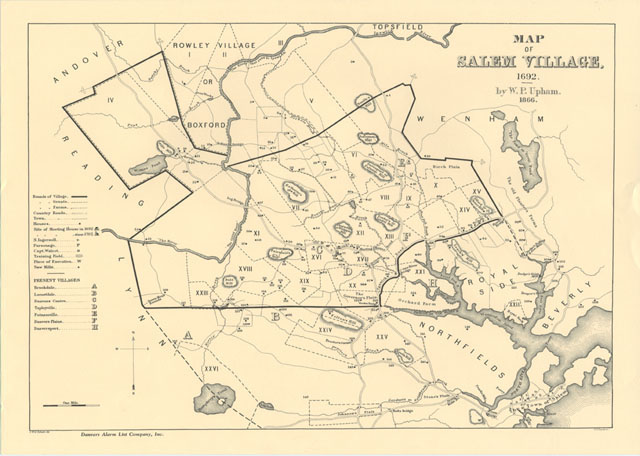
Fig. 4. 2. Map shows the locations of major landmarks,
farms, land grants, physical features, and the dwellings of promient and
important residents in Salem during 1692. The island in the lower left
corner is Humphry's Island in West Peabody.
A movement broke out at the turn of the eighteenth century for a separate
church for the village and in 1710 the Middle Precinct of Salem was formed.
In 1752, it was incorporated in the district of Danvers and was called
the southern village, or parish.
The second half of the nineteenth century brought residents increased
educational and economic opportunities that reinforced the cosmopolitan
picture of the area painted in the earlier part of the century by Washington
Irving.
In the Flowering of New England, he described a cultivated society
with “great square mansions” that “faced the sea or lined the stately
streets, with their beautiful gardens, cultivated by Scotch and Irish gardeners”.
He also reported that there were “notable scholars in charge of the young”
and that it was a “time of stirring intellectual life.”
In 1850, there were twelve, over-crowded district schools and two new
high schools. The moving force in town politics behind the move to create
a public high school was JOHN W. PROCTOR.
He was a lawyer and judge, as well as a long-time member of the Danvers
school committee. He evidently was also a supporter of educator HORACE
MANN, who was then the first Director of the state Board of the Education.
During his tenure, Mann managed to get a law passed that required towns
of a certain size population to provide a free high school. When the town
of Danvers did not abide by this new law, Proctor educated the townspeople
and succeeded in getting the town to vote to create two high schools, one
in the south and the other in the central part of Danvers.
“Local interests overpower mental needs – and because there is some
doubt just where to place a high school, the town sagely and illegally
heretofore have determined not to have any,” said Proctor. “So, if our
young men and women wish for higher than common education, they are obliged
to leave their home, and take their talents and energies elsewhere.
What thus the town may lose, cannot be calculated.”
At the same time that the town’s new high schools opened, a new bank,
the Danvers Savings Bank, opened its doors. It joined four other financial
institutions: Village Bank, Danvers Bank, Warren Bank, and the Danvers
Mutual Fire Insurance Company.
The temperature was sweltering on June 16, 1852 when twelve hundred
people gathered for a banquet under a large tent erected off Crowninshield
Street in the south village. The dinner marked the finale of a day
of spirited and patriotic observances to commemorate the one hundredth
anniversary of the separation of the town of Danvers from Salem, Massachusetts.
An elaborate parade that measured nearly a mile-and-a-half stepped off
at ten o’clock, passing triumphal arches of evergreens, flowers and flags
and including eight hand-pump fire engines and companies, contingents from
each of the public schools, and floats with a tableaux of scenes.
A cavalcade of three hundred horsemen promenaded through the streets to
the Old South Meeting House where three hours of services and choral
performances were held.
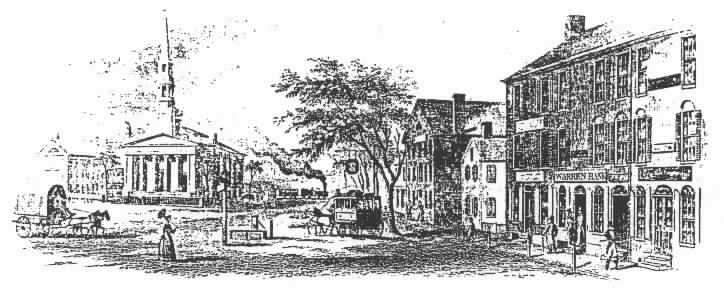
Fig. 4.3. The Square 1848.
A procession was formed and ticket holders walked to the “large canvas
pavilion” and entered under escort of the Military and Firemen.
After dinner was served, a lengthy “intellectual repast” was planned.
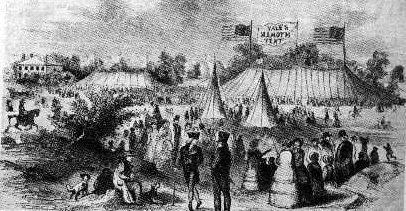
Fig. 4.5. Danvers Centennial
Celebration 1852.
One of the highlights
of the evening was the mystery surrounding a letter that had arrived from
London. It was from Danvers native and international merchant GEORGE
PEABODY. The town’s most famous son, Peabody was invited to the celebration
but declined the invitation. Instead, he sent a sealed letter with
instructions that it not be opened until the speeches were to be made at
the centennial event.
“…At the proper moment the reading of the
communication was called for; and the following was received by the delighted
audience with loud acclamations:
"By GEORGE PEABODY, of London;
EDUCATION – A debt due from present to future generations.
In acknowledgment of the payment of that debt by the generation which
preceded me in my native town of Danvers, and to aid in the prompt future
discharge, I give to the inhabitants of that town the sum of TWENTY THOUSAND
DOLLARS, for the promotion of knowledge and morality among them…..for the
purpose of establishing a Lyceum for the delivery of lectures, upon such
subjects as may be designated by a Committee of the town, free to all the
inhabitants...and that a library shall be obtained, which shall also be
free to the inhabitants."
The announcement caused a great stir. Although most of the people
in attendance were not personally familiar with George Peabody, a few recalled
knowing him in their youth and attributed his gift to education to the
value he placed on his limited education in common schools.
He was the third son in a poor family. For five years, between
the ages of seven and eleven, he attended one of the town’s two district
schools. The school was primitive and George attended only
for a few months when he could be spared from work at home.
By 1852, opportunities for higher education in the town of six thousand
people had improved. A special town meeting was held less than
two weeks after the gift was announced and it was voted unanimously to
accept the endowment and to name the institution “the Peabody Institute.”
The town followed Peabody’s advice and defined the Lyceum as an institution
where people could acquire knowledge and deemed that it not to be used
“for political ends or as a center of heated religious arguments.”
Twelve men were elected to serve on the Board of Trustees to oversee
the Institute’s funds and property and another board, the Lyceum and Library
Committee, was selected to direct the operations of the Institute.
The south village became the town of South Danvers
– eighty years after some citizens first called for a division between
the largely rural and port section of north Danvers and the manufacturing
center of southern Danvers. Legal and amicable on the surface, the
decision to divide was laden with heavy-handed politics.
Town meeting was held alternately at the high school in each section
of Danvers. In February 1855, it was held in the Peabody High School
on Stevens Street in the southern village. A resolution was presented
requesting the state Legislature divide the town using boundaries that
largely replicated the original bounds set in 1710 for the old Middle Precinct.
Several votes were taken and no agreement found. About seven o’clock,
residents voted 235 in favor of separation and 141 opposed. “It was
reported that voters from South Danvers kept delaying the meeting until
the hour of the final vote, as it was getting dark, and many of the farmers
of North Danvers had to leave to take care of their cows and chores.
So, some went and the vote went in favor of those who wanted to divide
the town.”
A month later, a special meeting was held in the North Parish to vote,
by ballot, on the petition of Benjamin Goodridge to divide the town.
“At this meeting, the advocates for division of South Danvers, relying
on the vote already secured, wisely let the day go by default, when they
refused to vote and the vote cast represented only the North Danvers vote.
The people of North Danvers appointed six men to oppose the division.”
The bounds of the village to the east were also changed. An act of the
Legislature passed on April 30 changed the ancient boundary between Salem
and South Danvers. Prior to the change, it was reported that the
line “ran through a house on Main Street, through a bedroom and across
a bed, so that the heads of the occupants were in Salem and their feet
in South Danvers.”
The new town of South Danvers had a population of 5,348 and a territory
of seventeen square miles. In May, 1855, an act to incorporate the town
of South Danvers was presented to the Governor and passed by the state
legislature. Fireworks and bonfires were part of the jubilant celebration
that followed the announcement in South Danvers, which represented the
larger part of the old town both in population and in valuation.
Three months later, George Peabody announced his plans to revisit the
United States. The town of Danvers voted to cooperate
with the new town of South Danvers to host a reception for Peabody. Two
committees were appointed to make arrangements in behalf of the old town
of Danvers, as it existed previous to the separation. The towns also
voted to equally share the expenses.
Reinforcing his reputation as a peace-keeper, Peabody accepted
the joint invitation of the town. Original plans calling for a low-key
celebration with “the feeling of a family meeting” were enlarged into a
grand event. The simple village festival became almost
national in character.
When the towns split, South Danvers had eight districts and sixteen
schools with 1,392 pupils and thirty teachers. The town paid
ten thousand dollars for the support of public schools, on a valuation
of three million dollars.
South Danvers included twenty-seven tanneries, twenty-four currying
shops, thirteen morocco shops and one patent leather factory. There
were twelve shoe manufacturers and five wool manufacturers, as well as
the Danvers Bleachery and the Davenport & Smith cotton mill.
Other industries included: three glue factories, two potteries, two bakeries,
two soap factories, a last factory, a box factory, four carriage builders
and working quarries. Dairy and farm products, including onions and
apples, constituted the town’s agricultural industries. The new town accounted
for seventy percent of the total valuation of the original town of Danvers.
.
|





